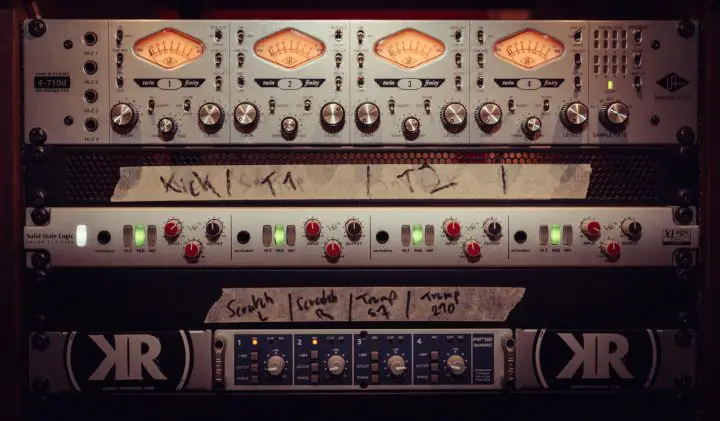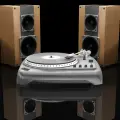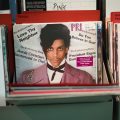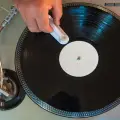Today we will elucidate 4 of the best amplifiers for turntables on the market and (if you are willing to stick around until the end) a whole bunch of the most important pieces of jargon for the discussion and understanding of this part of the audiophilic world.
Table of Contents
| Image | Title | Price | Prime | Buy | Buy |
|---|---|---|---|---|---|
 | Pyle Home Audio Power Amplifier System | PrimeEligible | Buy Now | Buy Pyle Home Audio Power Amplifier System | |
 | Yamaha A-S501BL | PrimeEligible | Buy Now | Buy Yamaha A-S501BL | |
 | Kinter K2020A+ | PrimeEligible | Buy Now | Buy Kinter K2020A+ | |
 | Douk Audio X1 | PrimeEligible | Buy Now | Buy Douk Audio X1 |
Best Affordable Amplifiers
So, without further ado, let us get into the main meat of the matter as we detail four of the best and most affordable amplifiers for turntables available on the market at the moment, even high end turntables.
1. Pyle Home Audio Power Amplifier System
With a less-than-catchy name, this surround sound amplifier still exceeds expectations and is likely one of the best phono amplifiers around at this price.
The Pyle is versatile and can be used for a whole host of different settings and environmental contexts, allowing the user to customize the output with dedicated equalizer controls.
A power amp like this is going to bring any sounds you feed into it alive; made with high-quality materials that are likely to last a long time while still sporting a compact design that contributes to the streamlined and nuanced quality of the sound.
Pros
- The unit is overall rather affordable, especially considering all the features.
- Sports a durable build quality with a streamlined design sense that is mirrored in the tonal qualities of the amplifier
- Powerful performance; it is a power amp after all, so what else would you expect?
- Protection from overheating, unlike a lot of other similarly priced competitors.
Cons
- Sadly lacking in any high power headphone output, which certain other similarly priced power amps of a similar ilk have been known to feature; thus an extra attachment would be necessary to fully realize this aspect.
2. Yamaha A-S501BL
Coming in at a slightly higher price point, there is this offering from all around sonic synthesists Yamaha. Taking a break from all their other relative sonic explorations – such as those in instruments, for example – they have brought forth an integrated amplifier with a solid and unencroachable construction.
While coming in at a higher price point, it is well worth the investment as it is likely to last you for years, boasting a firm and durable build and a whole host of other useful features.
The design is definitely one for those who prefer older iterations of amplifiers, with keen attention to detail for all the relative minutiae. There are 5 line inputs, and yet a standby power consumption of only half a watt.
Though lacking in compatibility with USB capabilities, it can, of course, connect to a TV, a Blu-ray player, a turntable, and anything you can think of that uses RCA inputs with an RCA cable.
Pros
- High power outage with a low standby power usage to match.
- Spacious and nuanced sound reproduction.
- Noteworthy and sturdy build quality.
- Easy to use and handily labeled so as to provide an easy-going user experience.
- Bluetooth compatible with the addition of an extra piece of hardware.
Cons
- The Bluetooth aspects are not built into the unit and will thus require an additional amount of money to enable.
- There is no opportunity for connecting the amplifier to anything else via USB – it is simply out of the question.
3. Kinter K2020A+
For those on the deepest budget imaginable, there is always this offering from Kinter to allow you to bridge the gap between the various elements in the home stereo system chain.
Despite being so compact and so affordable, this amplifier still comes with an additional 3.5mm input jack as well as a set of humble equalizer controls – tone, treble, and bass, alongside a comfortable volume control.
For the price, the sheer compatibility of this amplifier is unmatched, with a 3.5mm input jack that can accommodate almost any input imaginable, enabling connections beyond the call of duty.
All connectors are gold plated and said to last a significant amount of time, with a low resistance and thus a reduced risk of losing nuances in parts of signals. And, on top of all this, the amplifier is remarkably easy to set up!
Pros
- Boasts an incredible versatility that is more or less unmatched by other amplifiers of a similar price range.
- Gold-plated connectors ensure low resistance and, thus, a lower chance of losing parts of the signals to impedance.
- Remarkably durable build, especially considering the criminally low price point
- Which, considering all of the aforementioned features, is without competition on the market today.
Cons
- The design could be better, with perhaps a more intuitive user interface. Some of the knobs, for example, are disproportionately bigger than others, which can be to its disadvantage.
4. Douk Audio X1
This amplifier system is classy and stylish, boasting a complex and classic design that is still thoroughly easy to use, being completely compatible with all sorts of other audio systems, including phones, CD players, tape machines, TVs, computers, record players, etc.
This amplifier uses vacuum tubes to process the audio in a warm and analog way while still reproducing sounds clearly. The sound, even quietly, is powerful and nuanced.
Of particular note are the equalizer settings, which provide the user with the ability to sculpt the sound they hear into something as nuanced as their own ears and taste.
Not only that, but this amplifier also allows for Bluetooth connectivity straight out of the box, compatible with several different versions of Bluetooth to produce high quality sounds without a hitch.
The 4 switches are for 1) choosing between RCA inputs, phono inputs, and Bluetooth; 2) choosing whether or not to use the tube as a buffer; 3) choosing whether or not to bypass the tone circuit entirely; and 4) adjusting the tube light.
Pros
- A high quality Bluetooth compatibility
- At a considerably reasonable price considering all of the various advantages and features of the amplifier.
- Relatively light in weight, meaning it is easier to transport around.
- Stylish and classic design.
Cons
- The use of vacuum tubes makes this a decidedly more delicate amplifier, more prone to breakage, and in more need of care, much like a guitar amplifier.
Some Key Terms
Before getting into some of the best amplifiers for turntable options, it would be best to gloss over some of the key terms, those that will relate most to amplification within the lexicon of music technology.
Amplifier
Whether an integrated amplifier or power amplifier, this is a device that seeks to increase the volume of a signal – heightening voltage and/or current. This signal will almost always need to be preamplified with a dedicated amplifier, something that most modern iterations of the turntable tend to come with, built in as standard.
Clipping
This is a term for a type of distortion, one that can occur overloads and surpasses in volume the capabilities of the amplifier in question, which in turn causes the sound to become distorted and filthy sounding (sometimes in the best way).
This is, however, usually something undesirable to most, or at least something that an audiophile would encourage you to avoid subjecting your stereo receiver to, as it can do a fair amount of damage to several of the other elements in the chain, including phono preamps, the headphone output, and (as mentioned) the stereo receivers.
Distortion
If you have any idea about clipping or have heard what you surmise to be clipping, even through digital inputs, then you will know about and/or have heard distortion. By definition, it is a quality that degrades the original fidelity of a signal.
For some styles of music, this is desirable if not entirely vital, and for some, this is something to be avoided at all costs. In playing back these styles of music, it is more than likely going to be something one wants to avoid, especially if looking to play back the audio as accurately as possible.
Decibels (dBs)
Decibels are a relatively ubiquitous relative unit of measurement equal to one-tenth of a bel, expressing ‘the ratio of two values of a power or root-power quantity on a logarithmic scale.’
‘The definition of the decibel originated in the measurement of transmission loss and power in telephony of the early 20th century in the Bell System in the United States. The bel was named in honor of Alexander Graham Bell, but the bel is seldom used… In electronics, the gains of amplifiers, attenuation of signals, and signal-to-noise ratios are often expressed in decibels.’
Headroom
This is a more abstract and less easily definable quality of amplifiers to be able to accommodate for sudden louder passages that seem to come out of nowhere and are usually preceded by nothing.
These kinds of crescendos are often to be found in classical music, where tonal and timbral painting is all the rage. The better amplifiers are, the better they will be able to accommodate for these sudden washes and stabs of sound, regardless of whether they are integrated amplifiers or separate units.
What can be mistaken for the fault of scratches in a record can just as easily be caused by a poor amplifier unable to react quickly enough to these sudden shifts in dynamics and volume.
Integrated Amplifier
This brings us right to our next definition, wherein we consider the precise meaning of an integrated amplifier. You might already even have guessed, for the clue is very much in the name anyhow.
If an amplifier is to be called integrated, then it has to include both a phono preamp and a regular amplifier, integrating these two elements into one unit. An integrated amplifier will almost certainly accord inputs for other kinds of equipment – i.e., CD players, tape players, decks, etc.

Preamplifier
So, if an integrated amplifier is one that contains both a power amp and a preamplifier, then we must assess what a preamplifier is. After all, why the need for one amplifier before another one?
The signal from a phono cartridge of digital input alone is usually too weak to be amplified alone; the sound would be of an inadequate fidelity and would lend itself to distortion and the like. Thus, a preamplifier prepares this weak and quiet signal for being amplified by the real deal in the next stage of the process.
Receiver
And so, if an integrated amplifier is one that contains both an amplifier and a preamplifier with a built-in phono stage, a receiver is an integrated amplifier that also contains a tuner – i.e., the kind of tuner that one would use to listen to the radio.
Ohm
This definition has come to stand in for a unit of impedance, or what is otherwise known as electric resistance. Needless to say, this is so inherently tied together with the impedance of a set of speakers, which in its own way has come to mean the electrical character of a speaker that restricts or impedes the flow of power from an amplifier.
This is more or less what sound is when it is being reproduced aloud. An official definition might go something like this:
‘The ohm is defined as an electrical resistance between two points of a conductor when a constant potential difference of one volt, applied to these points, produces in the conductor a current of one ampere, the conductor not being the seat of any electromotive force.’
Peak Power
Though this sounds like something entirely different, it is, in fact, representative of a definition we have already come across in this audio system, more or less another way to express the concept of amplification headroom via the phono input.
In other manner of speaking, the peak power is the maximum wattage that an amplifier can produce for a brief period of time.
Wattage
This handily brings us to the concept of wattage itself. In essence simply a gauge of the potential power of a stereo amplifier over an audio signal (as calculated via the equation of current multiplied by voltage).
‘The watt is named after the Scottish inventor James Watt. The unit name was proposed initially by C. William Siemens in August 1882 in his President’s Address to the Fifty-Second Congress of the British Association for the Advancement of Science.
‘Noting that units in the practical system of units were named after leading physicists, Siemens proposed that watt might be an appropriate name for a unit of power.’
RMS
An average measurement in this context might, for example, be 80 watts RMS, meaning that this is the average volume at which the unit sounds best when transmitting audio, with or without a separate preamp phono stage or an integrated amp (though always with a dedicated phono input).
Or, Root Mean Square. This is a common mode of parlance for communicating amplifier measurements, one of the most common ways to measure the average value of an audio signal as fed through the amplifier in question.
Final Tones
So, there you have it! Hopefully, you are now feeling better able to navigate what might previously have felt confusing and/or insurmountable, better equipped with the important points of reference and terminology that are going to enable you to better discuss these things with a professional in a store or another enthusiast of your ilk.
Perhaps you even have your eyes set on a particular amplifier from the roster above now and are getting yourself ready to make a potentially unwise financial investment!
FAQs Amplifier for Turntable
What kind of amplifier do I need for my turntable?
There is no one ubiquitous amplifier for each different style and brand of a turntable, so you will have to make the judgments on the final call for yourself. Thankfully, this should be a more or less intuitive process, and there are very few examples of amplifiers that would not work a certain turntable and vice versa. That is to say that most amplifiers will work with most turntables.
Do I need an amp for my turntable?
While you might not need an amplifier per se, you will more than likely need something to act as an intermediary between the turntable and the speakers unless of course, they are an all-in-one unit, like vintage record players for instance. Depending on one’s definition of an amplifier, you might not need one at all, certainly not the more traditional idea of one, wherein a set of tubes process in analog fashion the sound sent forth from the turntable cartridge. A stereo system of some sort will, however, be necessary to act as an intercessor between the speakers and the turntable.
Can I connect a turntable directly to an amplifier?
More or less, yes. Most modern iterations of the turntable come equipped with a preamplifier built into them as standard. The preamplifier is vital in preparing the otherwise rather weak signals that come straight from the turntable cartridge to be processed by the amplifier itself. If the turntable in question does not have a preamplifier of its own, then you will need to purchase a separate unit for precisely this purpose, adding another piece to the stereo system puzzle.
Do you need a preamp and an amp for a turntable?
Nowadays, turntables typically have a preamplifier integrated into them as a standard feature. This preamplifier plays a crucial role in prepping the typically weak signals that originate directly from the turntable cartridge so that they can be processed by the amplifier. However, if the turntable you’re using does not come with its preamplifier, you’ll need to purchase a separate unit specifically for this purpose, which will add another component to your stereo system.. Some sort of intercessor is necessary to act as a translator of the signals from the turntable and then from the preamp to the desired set of speakers. This can be a stereo system or a more traditional amplifier.










